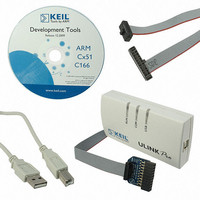ULINKPRO Keil, ULINKPRO Datasheet - Page 31

ULINKPRO
Manufacturer Part Number
ULINKPRO
Description
KIT DEBUG/TRACE UNIT HIGH SPEED
Manufacturer
Keil
Type
In-Circuit, Real-Time Debugger/Programmerr
Specifications of ULINKPRO
Contents
Module
For Use With/related Products
ARM7, ARM9, Cortex
Lead Free Status / RoHS Status
Lead free / RoHS Compliant
- Current page: 31 of 157
- Download datasheet (8Mb)
30
Coding Hints for C166, XE166, XC2000 Architectures
Hint
When possible, use 16-bit data
types for automatic and
parameter variables.
Replace long with int data types
when possible.
Use the bit data type for boolean
variables.
Use the SMALL or MEDIUM
memory model when possible.
When using other memory
models, apply the near, idata, or
sdata memory type to frequently
used variables.
Use the memory model
HCOMPACT/HLARGE instead
of COMPACT/LARGE.
Use near pointers when
possible.
Description
Parameter passing is performed in 16-bit CPU registers (many
16-bit registers are available for automatic variables). More 16-
bit variables (signed/unsigned int/short) can be assigned to
CPU registers. This generates code that is more efficient.
Operations that use 16-bit types (like int and unsigned int) are
much more efficient than operations using long types.
These CPUs have efficient bit instructions that are fully
supported by the Keil C166 Compiler with the bit data type.
In these memory models, the default location of a variable is in
near memory, accessible through16-bit direct addresses
encoded in the CPU instructions. You can locate large objects
(array or struct) into huge or xhuge using explicit memory
types.
Variables in the near, idata, or sdata address space are
accessed through a 16-bit address that is encoded directly into
a single C166/XE166/XC2000 instruction. These memory types
generate the most efficient code.
The memory models COMPACT and LARGE use the obsolete
far memory type and have an object size limit of 16KB. The
memory models HCOMACT and HLARGE use the huge
memory type that feature a 64KB object size limit. Even cast
operations from near to huge pointers are more optimal.
Check if a near pointer is sufficient for accessing the memory,
since near pointers can access variables in the near, idata, or
sdata address space. Near pointers generate faster and
smaller code.
Chapter 2. Microcontroller Architectures
Related parts for ULINKPRO
Image
Part Number
Description
Manufacturer
Datasheet
Request
R

Part Number:
Description:
MCU, MPU & DSP Development Tools USB-JTAG Adapter
Manufacturer:
Keil Tools
Part Number:
Description:
KEIL C-COMPILER INTERNATIONAL
Manufacturer:
Silicon Laboratories Inc
Part Number:
Description:
KEIL C-COMPILER US VERSION
Manufacturer:
Silicon Laboratories Inc

Part Number:
Description:
DEV KIT FOR STM32
Manufacturer:
STMicroelectronics
Datasheet:

Part Number:
Description:
KIT STARTER FOR STM32
Manufacturer:
STMicroelectronics
Datasheet:

Part Number:
Description:
KIT STARTER FOR STM32F10XE MCU
Manufacturer:
STMicroelectronics
Datasheet:

Part Number:
Description:
KIT STARTER KEIL FOR STR910
Manufacturer:
STMicroelectronics
Datasheet:

Part Number:
Description:
Microcontroller Modules & Accessories KEIL ULINK PRO 5V ADAPTOR KIT
Manufacturer:
Keil Software

Part Number:
Description:
Development Boards & Kits - ARM KEIL NUVOTON EVAL BD CORTEX-M0 + ULINK-ME
Manufacturer:
Keil Tools
Datasheet:

Part Number:
Description:
Development Boards & Kits - ARM KEIL NUVOTON EVAL BD CORTEX-M0
Manufacturer:
Keil Tools
Datasheet:

Part Number:
Description:
BOARD EVAL FOR LPC213X ARM MCU
Manufacturer:
NXP Semiconductors
Datasheet:
Part Number:
Description:
K60N512 Keil Tower Kit
Manufacturer:
Freescale Semiconductor
Datasheet:












